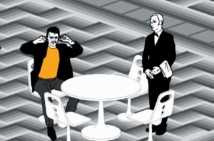Submarine Channel

Existentialist Chunk
Existentialist Chunk
We were struck by the strong graphic qualities of Schrdinger’s Room – a short, heavily post-produced film, published under a Free Art license. When we took a closer look at the film, we found that it has a deeper philosophical, existentialist layer. It was made by the twenty-something French artist Sthane Drouot, who operates under the Lacrymosa Industry moniker. Drouot says he was inspired by a famous thought experiment by quantum physicist Erwin Schrdinger.
We wanted to know a bit more about the film and asked Drouot, well, to explain himself, in a non-nerdy fashion.
Please tell us a bit more about Schrödinger’s Room and what inspired you about quantum theory?
Schrödinger’s Room is the first film of the quantic triptych. I realized one day that philosophy, physics, myths and theology are actually various ways of trying to achieve the same goal, which is to find the meaning of life, a sort of divine pattern. And this is particularly the case with quantum physics. I found it very peculiar to see that its implications and developments tend to act more like faith than anything I’ve ever encountered in science.
So, this film is part of a triptych, which is a religious art form, and the quantum thought experiment this film find its root in, is the famous Schrödinger’s cat-in-the-box thought experiment. Like Schrödinger’s cat, our hero Bastien, is at the same time both alive and dead. In his case it’s a state of mind, meaning that the continuous repetition of the same routine keeps him from being actually alive.
It’s quite a moody and introspective film. What did you want to express?
The purpose of this series is to journey through the human psyche expressing the eternal search for a reason for being. I can’t imagine a way to question yourself and put your life in perspective that wouldn’t be painful. It’s painful because you need to accept a lot of your own defaults in order to be able to move on. And most of all, dealing with self mortality is always an issue that most people tend to ignore in order to sleep better. Although it always seemed to me that fulfillment came with improving who you are as a human being and determining your place in the world, this is a rather tiresome process, and my treatment of the subject depicts exactly that… if you want to actually wake up and take back your life, you need to choose to do so.
When shooting, did you already know you were going to go for this extreme stylization?
The moment the script was written, it became obvious that I needed to mess with the picture. It took about three days to develop the final look for the movie. I had to pay particular attention to lighting during the very short shooting period – around 4 hours total – to ensure that I’d be able to create the picture I was looking for. This style serves the purpose of the film. I wanted an image that only makes sense in motion. If you pause the film and try to guess what it is you’re looking at, chances are, you won’t be able to decipher the image. Most of all, it symbolizes the loss of meaning and loss of self.
You composed the music yourself, right?
Yes I did. We had very little time to make this movie, I wanted music that was simple, repetitive, to accentuate the repetition and the sound of the alarm clock. I then contrasted these inside-the-room and inside-the-box themes to the exterior scene for which I used waltz-like rhythms, which sound less mechanical, more lively. When Bastien leaves the room, the two modes mix together to create a very dynamic piece.
Where does the name Lacrymosa Industry come from?
It’s an alias I’ve had for ten years now. Lacrymosa is the Latin word for “tearful” and comes from my studies of classical music as a teenager. The tearful industry relates to the fact that I’m not such a jolly kinda person – although some people would tend to disagree – and instead of feeling down all the time and remaining in bed crying, I use the energy of sorrow to convert it into whatever media I can lay my hand on, whether it’s music, film making, 3D graphics, writing…
Why did you decide to publish it under a Free Art License? (Anyone can redistribute, copy and modify your film freely according to terms defined in this license)
The Free Art License is the way I chose to work a long time ago. It seems to me like the most humane behavior. Moreover, it’s the way of the future! I know it can be a bit hard to get, given the actual climate in copyright laws and all, but it’s where we all will go once people take the “will to create” back. Anyway, I truly believe that copyright culture prevents creativity and intellectual evolution, both personal and worldwide, so I’m just not doing it.



